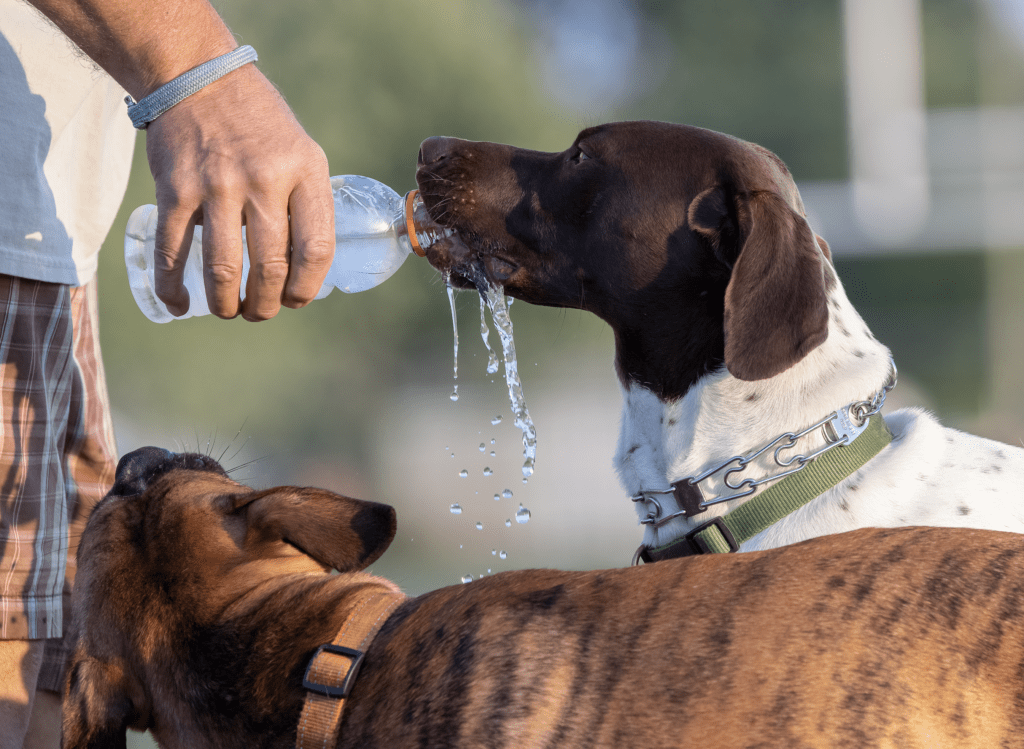Share This Blog With Other Pet Parents!
Heat Stroke in Pets: Recognising Signs in Dogs and Cats
As the sun beats down during the peak summer months, we all look for ways to stay cool. But imagine wearing a fur coat in this sweltering heat… That’s precisely the situation our pets, be it dogs, cats, or other furry companions, find themselves in.
Every year, numerous pets suffer from heat stroke due to high temperatures. This is particularly prevalent in Queensland, where the summers are dry, long, and hot! Recognising the early signs of heat stroke and understanding how to prevent this life-threatening condition is crucial. This comprehensive guide aims to arm you with the knowledge to protect your pet from the dangers of heat stroke, ensuring they remain happy, healthy, and by your side for many summers to come.
What you’ll learn from this blog:

For all you need to know, download our
FREE Dental Guide
This blog is part of our Proactive Pet Parent series! This is just the beginning… To see more blogs, click here! Better yet, sign-up to our newsletter to receive these directly to your inbox each month.
Sign-up To The Proactive Pet Parent Newsletter
The Importance Of Awareness
Heat stroke isn’t merely a case of feeling a tad too warm; it’s a critical, often life-threatening situation where a pet’s body temperature rises beyond a safe limit. The consequences can be dire if not addressed promptly. While the heat may feel comforting to you, for a dog or cat, it can be like wearing a winter jacket in the middle of a heatwave.
While most pet owners are vigilant about not leaving their pets in parked cars during hot weather, many may not be aware of other common scenarios where their pet is at risk. Recognising the early signs of heat stroke and knowing what steps to take can mean the difference between a close call and a tragic loss. It’s a responsibility that comes with the joys of pet ownership, and knowledge is the first line of defence. With the right information, every pet owner can ensure their furry friend stays safe, healthy, and happy throughout the hottest months of the year.
Understanding Heat Stroke
Heat stroke is a condition characterised by an elevated body temperature due to prolonged exposure to high temperatures, often combined with dehydration. It is a type of hyperthermia, where the body produces or absorbs more heat than it can dissipate. In simple terms, it’s when the internal thermostat of your pet goes haywire, and their body can’t cool down efficiently. Unlike humans, dogs and cats have a limited ability to sweat. They primarily release heat through panting and a small amount through the pads of their feet. When these natural cooling methods become ineffective, their core body temperature rises, leading to heat stroke.
So, what happens inside the body during this critical condition? As the temperature escalates, it can lead to a cascade of detrimental internal events. Vital organs such as the heart, kidneys, and brain begin to suffer from the heat. Cells can break down, leading to dehydration and a lack of vital nutrients. Moreover, the increased temperature can cause proteins in the body to change, effectively impairing their function. It’s a rapid downward spiral, with every minute counting when it comes to effective intervention.
Some factors amplify the risk of heat stroke. Brachycephalic breeds (those with short noses like pugs or Persian cats), older pets, or those with underlying health conditions are at a higher risk. Additionally, obese animals, those not acclimated to warm climates, or pets with thick or dark-coloured coats are also more susceptible. While any pet can suffer from heat stroke under the right conditions, being aware of these added risk factors can help pet owners be even more vigilant during the sweltering summer months. Prevention is always better than cure, especially when the stakes are as high as the well-being of our four-legged friends.
Signs and Symptoms of Heat Stroke in Dogs
When it comes to our canine companions, recognising the initial signs of heat stroke can make a critical difference in ensuring their safety. As a pet owner, understanding and detecting these early indicators can lead to swift intervention, reducing potential harm to your pet.
First and foremost, rapid, excessive panting is one of the most common and visible signs. Panting is a dog’s primary method of releasing heat, so if you notice your dog panting harder and faster than usual, it’s a tell-tale sign that they’re struggling to cool down. Additionally, a dog in distress might exhibit a bright red tongue and gums. This change in color is due to increased blood flow as the body attempts to cool down.
Another sign to be vigilant about is a change in their salivation. While drooling can be common in some dogs, excessive drooling or thick, sticky saliva can be indicative of heat stress. Also, dogs suffering from heat stroke might display signs of confusion, dizziness, or lethargy. They may be reluctant to move or might stumble when they do.
In more severe cases, you might witness vomiting or diarrhea, which can sometimes be bloody. Their pulse and heartbeat may become irregular, and in extremely critical situations, they might even experience seizures or fall into a state of unconsciousness.
Lastly, a simple yet telling symptom is an increase in their body temperature. If you have a pet thermometer, a reading above 39.4°C (103°F) is usually considered elevated for dogs. However, in cases of heat stroke, it can shoot up to 41°C (106°F) or higher.
Being adept at spotting these signs is essential. While enjoying outdoor activities or during hot spells, regular checks on your dog’s well-being, paired with an awareness of these symptoms, can prove invaluable. Time is of the essence when it comes to heat stroke, and every moment matters.
Signs and Symptoms of Heat Stroke in Cats
Cats, despite their independent demeanor, are equally susceptible to the perils of heat stroke. As stealthy and resilient as they might seem, it’s crucial for pet owners to be attuned to the subtle and sometimes overt signs of heat distress in their feline friends.
A primary indication is panting. Unlike dogs, panting isn’t typical for cats. If you notice your cat panting, it’s a significant warning sign that they’re finding it hard to regulate their body temperature. Along with panting, a cat’s tongue and gums may turn a brighter shade of red than usual. This discoloration indicates that they are overheated.
Moreover, cats may exhibit signs of restlessness as they seek cooler spots in the house or shade outside. This behavior is a cat’s instinctual method of finding relief from the heat. They might also spread their body out on a cool surface, trying to maximize the body area in contact with the cold.
Another noticeable sign is a decrease in their activity levels. A lethargic cat, especially during times when they’re usually active, is a cause for concern. Additionally, you might see a cat grooming more than usual. This is an attempt to cool themselves down through the evaporation of saliva.
In severe cases, similar to dogs, cats might also vomit, show signs of diarrhea, or even faint. Their heartbeat may become rapid or irregular, reflecting their distressed state.
It’s worth noting that while cats have a naturally higher body temperature than humans, a reading above 40°C (104°F) indicates that the cat is indeed suffering from an elevated body temperature, hinting at the onset of heat stroke.
Being observant and familiar with these signs in cats can lead to timely interventions. Just a little vigilance can ensure your feline companion remains safe and healthy during the hottest days.
What To Do If Your Pet Has Heat Stroke
Heat stroke in pets, whether feline or canine, requires swift and effective action to prevent severe health consequences or, in dire situations, loss of life. If you suspect your pet is showing symptoms of heat stroke, here are some urgent measures to take:
- Relocate to a Cooler Environment: The initial step is to move the pet to a shady, well-ventilated area. If indoors, ensure fans or air conditioning are on, creating a cooler ambiance.
- Hydrate: Offer your pet cool, not cold, water. It’s important to let them drink at their own pace. Avoid forcefully pouring water into their mouth, as this can lead to aspiration pneumonia.
- Lukewarm Baths: Immersing your pet in lukewarm water can help to gradually reduce their body temperature. Avoid using cold water, as this can cause shock or decrease their temperature too rapidly.
- Damp Cloth Application: If you don’t have immediate access to a bath, dampen a cloth with cool water and gently apply it to your pet’s body, especially around the head and neck. It’s essential to use water that’s cool, not cold.
- Air Circulation: Utilise fans to circulate air around your pet. The evaporation process will aid in reducing their body temperature.
- Check Temperature: Using a rectal thermometer, monitor your pet’s temperature every 5 minutes. Once it’s down to around 39°C (103°F) for dogs or a bit lower for cats, cease the cooling measures to prevent hypothermia.
- Seek Veterinary Attention: Regardless of whether your pet seems to recover quickly, always consult a veterinarian after a suspected heat stroke. There could be underlying damage or complications that aren’t immediately evident.
Being proactive and knowledgeable about the steps to take when faced with a potential heat stroke scenario can make all the difference. Every second counts, and understanding these actions could save your pet’s life.

Prevention is Better Than Cure
Navigating the risks of heat stroke in pets requires both awareness and proactive measures. Instead of reacting to distressing situations, the emphasis should be on creating a safe environment to prevent the onset of heat-related issues. Here are some key strategies to ensure the well-being of your pets during warmer months:
- Consistent Hydration: Always ensure that your pets have access to fresh, cool water. This aids in regulating their body temperature and keeps them hydrated.
- Shade and Shelter: If pets are outdoors, make sure there’s ample shade available. Even with shade, avoid leaving them out for extended periods during peak heat hours.
- Mind the Exercise: Limit strenuous activities during the hotter parts of the day. Opt for early morning or evening walks when temperatures are more moderate.
- Never Leave Pets in Cars: The temperature inside a parked car can soar quickly, even with windows slightly open. It’s a common misconception that leaving a pet for “just a few minutes” is safe.
- Use Cooling Products: Consider investing in cooling mats, vests, or bandanas designed specifically for pets. These products can help in maintaining a comfortable body temperature.
- Regular Grooming: For pets with thick coats, regular grooming can help in reducing excess fur, making them feel cooler. However, refrain from shaving them completely as their fur also provides protection from the sun.
- Be Cautious of Hot Surfaces: Asphalt and concrete can become scorching during the day, posing risks to your pet’s sensitive paws. Test surfaces with the back of your hand before allowing your pet to walk on them.
Adhering to these preventive measures not only safeguards your pets from potential harm but also ensures their overall comfort during warm weather. While heat stroke is a grave concern, with attentive care, it’s entirely avoidable. Knowledge paired with action lays the foundation for a safe and enjoyable summer for your furry companions.

Your Role As Pet Owner
Being a pet owner comes with a blend of joys, responsibilities, and learning opportunities. Each pet, whether feline or canine, exotic or domestic, brings with it unique needs and behaviours. A crucial aspect of pet ownership is understanding the inherent vulnerabilities pets face, especially when it comes to environmental factors like heat.
While professionals offer guidance on pet health and well-being, the daily choices made by pet owners play an integral role in safeguarding their animals from threats like heat stroke. Recognising signs of distress, providing ample water and shade, and adjusting daily routines in response to weather conditions are essential actions pet owners must take.
However, it’s also essential to note that every pet is an individual. What might be tolerable for one might be strenuous for another. For instance, older pets or those with specific health conditions may require extra precautions during warmer days. Hence, understanding your pet’s unique needs and being observant can make a significant difference.
With continuous research and evolving insights into pet care, there’s always something new to learn. Attending workshops, reading articles, or consulting with veterinarians can equip pet owners with the knowledge to make informed decisions.
Lastly, while vigilance is essential, it’s equally important to maintain a sense of balance. Overprotectiveness can restrict a pet’s freedom and joy, so finding the middle ground is key. Offering a safe environment while allowing them to explore and enjoy their surroundings results in a fulfilling life for both the pet and the owner.
Summing It All Up
Throughout our exploration of heat stroke in pets, we’ve uncovered its intricacies, pinpointed its signs in both dogs and cats, and emphasised the pivotal role of immediate action. Heat stroke in dogs and cats is a serious concern that requires attention to detail and a proactive approach. Knowledge is a powerful tool in preventing these situations, and as we’ve highlighted, awareness is the first line of defence.
It’s been evident that preventing heat stroke in pets goes hand in hand with understanding its symptoms and risk factors. While we have the means to react swiftly during an emergency, the adage remains true: prevention is indeed better than cure. By adopting preventive measures, pet owners can not only keep their furry companions safe but also foster an environment that prioritises their well-being.

